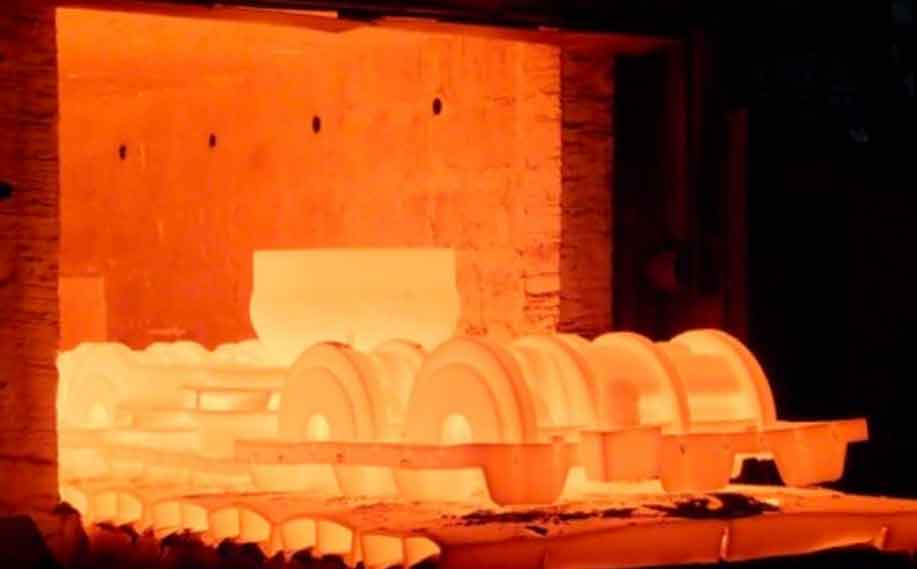Bucket teeth are critical wear components in excavators and loaders, directly contacting abrasive materials like soil and rocks. They endure significant impact, compression, and bending stresses, leading to wear, deformation, or fracture. To enhance durability, low-carbon alloy steels like 30CrMnSi are increasingly replacing traditional high-manganese steels due to their superior strength-toughness balance and cost-effectiveness. This study analyzes the microstructure, hardness distribution, and impact toughness of forged 30CrMnSi bucket teeth processed via forging residual heat quenching, identifying optimal parameters to mitigate common heat treatment defect risks.
Materials and Experimental Methods
The base material was 30CrMnSi hot-rolled bar stock, with composition verified by optical emission spectrometry (Table 1). Forged bucket teeth underwent segmented quenching: the tip was water-cooled immediately after forging (870–900°C), while the root underwent delayed quenching to simulate intercritical treatment. Post-quenching, samples were tempered at 200°C for 2 hours. To evaluate root properties, impact specimens were subjected to simulated residual heat treatments (Table 2). Hardness was measured using a Rockwell tester, impact toughness via Charpy U-notch tests, and microstructure analyzed using optical microscopy.
| C | Si | Mn | Cr | S | P |
|---|---|---|---|---|---|
| 0.291 | 1.053 | 0.950 | 1.032 | 0.014 | 0.024 |
| Group | Quench Temp. (°C) | Holding Time (min) | Cooling Method |
|---|---|---|---|
| 1 | 740 | 20 | Water |
| 2 | 770 | 20 | Water |
| 3 | 800 | 20 | Water |
| 4 | 830 | 20 | Water |
| 5 | 870 | – | Water |
| 6 | 900 | – | Water |

Results and Discussion
Microstructure and Hardness Distribution in Production Teeth
Segmented quenching yielded non-uniform microstructures: the tip exhibited fine martensite (M) due to rapid cooling, while the root formed coarser M (Figure 1). Hardness profiles reflected this gradient:
- Tip hardness: 48–52 HRC
- Root hardness: 40–45 HRC
Surface hardness was 2–3 HRC lower than the subsurface, attributed to oxidation and decarburization during forging—a common heat treatment defect reducing wear resistance. The root’s lower hardness resulted from delayed quenching, which coarsened prior austenite grains. Although intercritical quenching was intended for the root, insufficient cooling time prevented significant ferrite formation, limiting toughness gains.
Impact of Quenching Temperature on Simulated Specimens
Quenching temperature critically influenced phase composition and mechanical properties. Lower temperatures (740–800°C) produced varying ferrite (F) fractions, while temperatures ≥830°C formed fully martensitic structures (Figure 2). Hardness and impact energy followed distinct trends (Tables 3–4):
| Quench Temp. (°C) | Hardness (HRC) |
|---|---|
| 740 | 41.6 |
| 770 | 45.9 |
| 800 | 47.2 |
| 830 | 46.0 |
| 870 | 48.6 |
| 900 | 46.5 |
| Quench Temp. (°C) | Impact Energy (J) |
|---|---|
| 740 | 47.0 |
| 770 | 55.3 |
| 800 | 67.3 |
| 830 | 65.6 |
| 870 | 74.0 |
| 900 | 66.3 |
Impact energy peaked at 74 J for 870°C quenching, attributed to refined lath martensite. At lower temperatures (740–800°C), austenitization was incomplete, causing:
- Coarse ferrite clusters at 740°C, reducing toughness.
- Heterogeneous carbon distribution at 830°C, forming brittle high-carbon martensite zones.
At 900°C, austenite grain coarsening occurred, described by the Hall-Petch relationship:
$$ \sigma_y = \sigma_0 + k_y d^{-1/2} $$
where \(\sigma_y\) is yield strength, \(\sigma_0\) and \(k_y\) are constants, and \(d\) is grain diameter. Coarse grains degraded toughness despite high hardness. This temperature-induced brittleness represents a critical heat treatment defect in quenched components.
Optimization of Quenching Strategy
Segmented quenching failed to enhance root toughness due to inconsistent phase transformation. Integral quenching at 870°C is recommended, where simultaneous tip-root cooling achieves uniform fine martensite. This eliminates hardness gradients and suppresses heat treatment defect formation like soft surfaces or coarse microstructures. The optimal process window is defined by:
$$ T_{\text{quench}} = A_{c3} + (30 – 50)^{\circ}\text{C} $$
For 30CrMnSi (\(A_{c3} = 830^{\circ}\text{C}\)), quenching at 870°C balances solution homogeneity and grain refinement. Post-quench tempering at 200°C relieves stresses without over-softening, critical for avoiding premature wear or fracture.
Conclusions
- Segmented quenching creates hardness gradients (tip: 48–52 HRC; root: 40–45 HRC) and subsurface soft zones due to oxidation—a preventable heat treatment defect.
- Impact toughness maximizes at 74 J for 870°C quenching. Temperatures below 870°C cause ferrite-related embrittlement, while those above promote grain coarsening.
- Integral quenching at 870°C produces homogeneous fine martensite, enhancing overall hardness (48–49 HRC) and impact resistance. This approach mitigates common heat treatment defect risks, extending service life.
